Thousands of Indigenous Women March for Their Rights in Brazil
Celebrating victories and decrying injustices, the march was a rallying cry for Indigenous rights.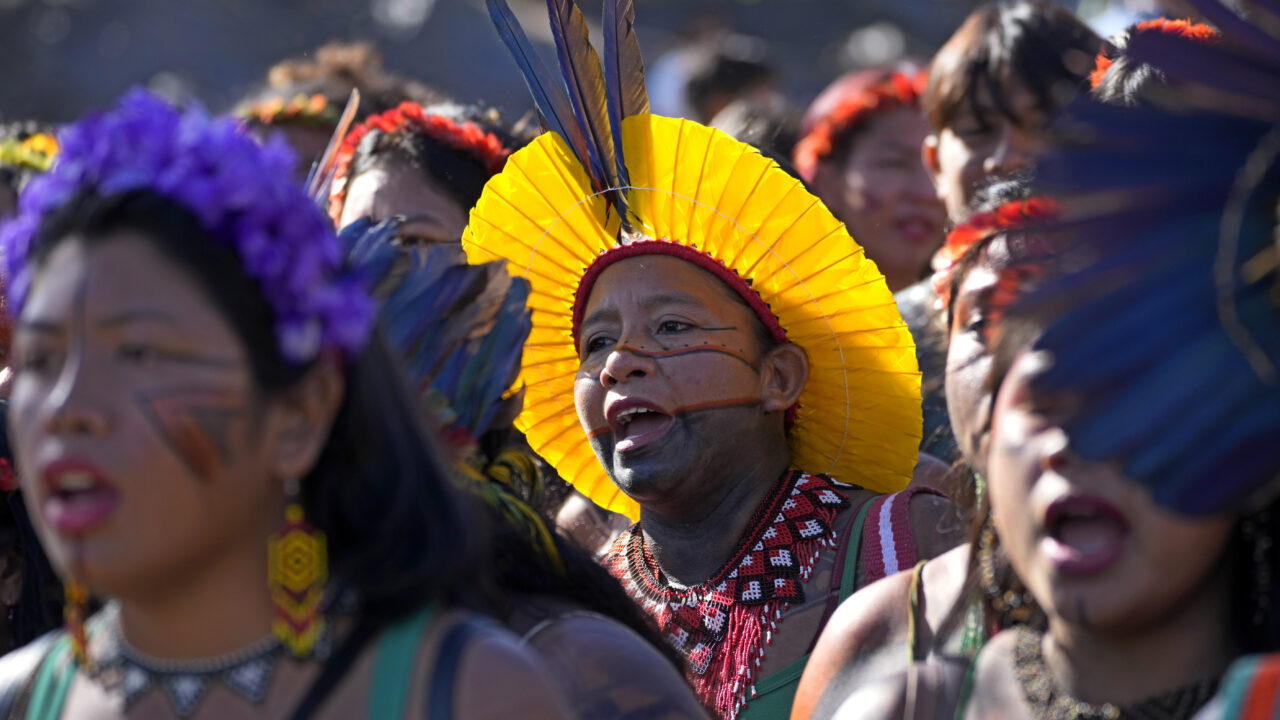 Indigenous women from across Brazil march at the end of a three-day event to strengthen the political role of Indigenous women in Brasilia, Brazil, Wednesday, Sept. 13, 2023. (AP Photo/Eraldo Peres)
Indigenous women from across Brazil march at the end of a three-day event to strengthen the political role of Indigenous women in Brasilia, Brazil, Wednesday, Sept. 13, 2023. (AP Photo/Eraldo Peres)
The sound of singing and maracas echoes from all sides of the camp as groups of women from all corners of Brazil approach the main tent, where they will gather for the Third March of Indigenous Women. It is 8 a.m. and the already extremely hot sun in Brasília, the country’s capital, highlights the colors of uncountable different traditional costumes.
The march is part of a three-day event marked by celebrations and denunciations. More than 5,000 Indigenous women from all 26 states in Brazil marched 4 km (2.5 miles) toward the National Congress to demand territorial rights and the end of gender-based violence.
This year’s guiding theme, “Women Biomes in Defense of Biodiversity Through Ancestral Roots,” emphasized the presence of Indigenous women in the six biomes of Brazil, which include rainforests, savannas, and semi-deserts. It also highlighted the crucial role these women play in preserving all of them. For Indigenous women, there is no separation between their territories and their own bodies. Their dependence on the land for both physical and cultural survival makes them the guardians of the nature that surrounds them.
“Our bodies, like Mother Earth, were seen by the Portuguese invader as an object to be subjugated, hunted, violated.”
“Indigenous women were the first target of attack since the invasion of Brazil. Our bodies, like Mother Earth, were seen by the Portuguese invader as an object to be subjugated, hunted, violated,” says Ávelin Kambiwá, of the Kambiwá people, specialist in public policies on gender and race. “With the Indigenous women’s movement, we make the leap from body-object to body-territory, and place ourselves on the front line of the fight to defend our rights.”

The Push and Pull of Progress
This year, the march took place under the most contradictory political context Indigenous people have seen in decades.
On the one hand, it was marked by relevant achievements. The current Congress has the largest Indigenous presence in the history of Brazil; the first-ever Ministry of Indigenous Peoples was created in January; and the demarcation of Indigenous territories, which had been abolished by the previous government, was resumed in April with eight new demarcations so far.
For Indigenous people, their territory is more than just a piece of land. It is part of their culture and history, and it is key to their survival. Once the area they occupy is demarcated, it is legally protected from invasions and from the abusive exploitation of outsiders. In short, demarcating land is the first step toward guaranteeing all other physical and cultural rights of Indigenous peoples.
On the other hand, even in progressive democratic governments, it is a struggle to bring issues concerning minority groups out of the shadows.
“Organizing this year’s march was challenging, especially in terms of finding sponsors to support us, financially and otherwise, so we could properly receive the thousands of women coming from the furthermost parts of the country,” says Cristiane Pankararu, of the Pankararu people, member of the National Articulation of Indigenous Women Warriors of Ancestry.
Demarcating land is the first step toward guaranteeing all other physical and cultural rights of Indigenous peoples.
She recalls how, in previous years, under an openly anti-Indigenous government, it was easier to engage partners. “This year, however, because we have a left-wing president, a lot of people assume everything is alright and all problems will go away,” she says.
But that is not the case. While president Luiz Inácio Lula da Silva is a leftist, the majority of Congress is occupied by right-wing and alt-right politicians, who have been joining forces to block social and environmental advances. Their main effort has taken the shape of the so-called Marco Temporal, which proposes only recognizing Indigenous lands occupied on the date of enactment of the 1988 Federal Constitution.
The proposed Marco Temporal is currently advancing on two fronts: The Supreme Court is judging whether or not this thesis is constitutional, while Congress is voting on a bill to implement it as a nationwide law. If it receives final approval, the bill will not only create new obstacles to Indigenous land demarcation, but also revisit the rights of Indigenous lands that have already been demarcated and homologated by the federal government, thus reigniting old (and igniting new) violent conflicts with farmers and land grabbers.
The Third March of Indigenous Women transpired between two sessions of Brazil’s Supreme Court—the first on August 30th, and the second, which should be decisive, on September 20th.
The last day of the event was marked by the presence of five female ministers: Indigenous Peoples; Women; Environment and Climate Change; Racial Equality; and Science, Technology, and Innovation. Together, these ministers signed a set of fundamental acts to combat violence and strengthen the participation of Indigenous women in public policies.
For Sônia Guajajara, Minister of Indigenous Peoples, the presence of Indigenous women in the march sends a strong message against the Marco Temporal in hopes that it will be defeated: “On other occasions, we have already managed to reverse many anti-Indigenous measures and many bills that aimed to roll back our rights,” she says.
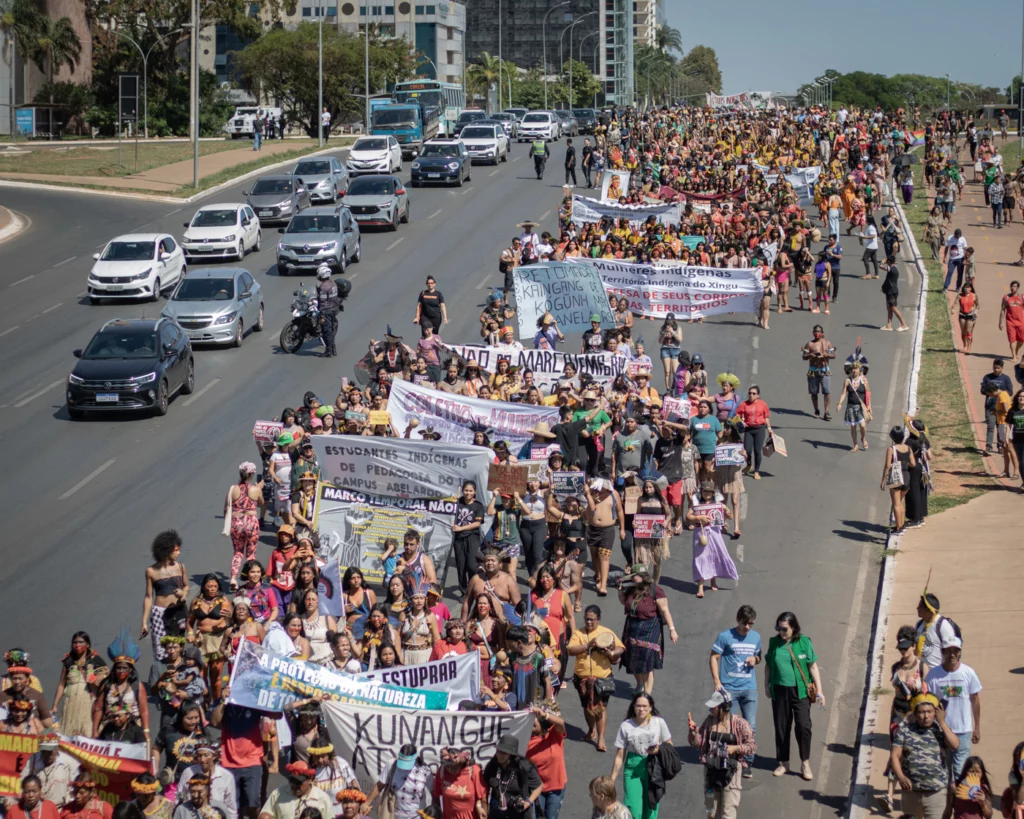
The Right to Exist
On September 11, the first day of the event, a symbolic court was held where women could make public denouncements on behalf of their people. The themes ranged from domestic violence and prostitution networks to the increase in suicide cases and arson in traditional prayer houses.
Land rights are crucial for guaranteeing all other rights of Indigenous peoples, but the women at the march didn’t stop there. Some made demands particular to their biomes, such as food insecurity in the Caatinga, a semi-desert region, and lack of political visibility in the Pampa, the southernmost region of the country.
Indigenous women will not let go of the spaces they have already won—and will keep fighting for their survival.
Above all, this year’s march was a celebration of political victories. For the first time ever, a solemn session was held in Congress, paying tribute to the Third March of Indigenous Women. At the same event, congresswoman Célia Xakriabá, one of three Indigenous women in congress today, officially filed a bill which aims to combat violence against Indigenous women.
As the Marco Temporal advances, however, the future of Indigenous rights is uncertain. The decisions made by the Supreme Court in the upcoming session could either consolidate rights or wash them down the drain. Whatever the case, Indigenous women will not let go of the spaces they have already won—and will keep fighting for their survival.
Cristiane Pankararu said, “We are marching today to support our representatives who are breaking the bubble, changing structures, and occupying decision-making positions. Whenever we tried to enter Congress, the House of the People, on previous occasions, we were met by national forces and repelled with pepper gas and rubber bullets. Today, we walked through the front door.”
Note: The interviews for this piece were conducted in Portuguese and then translated by the author.
Your support matters…Independent journalism is under threat and overshadowed by heavily funded mainstream media.
You can help level the playing field. Become a member.
Your tax-deductible contribution keeps us digging beneath the headlines to give you thought-provoking, investigative reporting and analysis that unearths what's really happening- without compromise.
Give today to support our courageous, independent journalists.



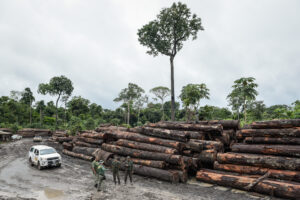
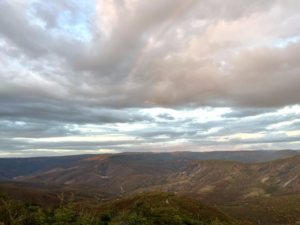
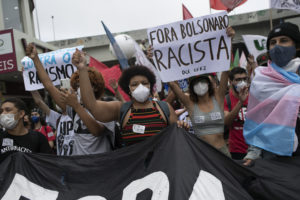
You need to be a supporter to comment.
There are currently no responses to this article.
Be the first to respond.